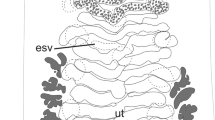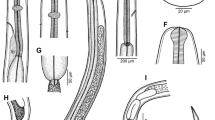Abstract
Dingularus n. g. is proposed to accommodate three new species, D. anfracticirrus, D. pearsoni and D. megapharynx, within the Plagiorchiida. Dingularus is closely related to the Plagiorchiidae, despite the unusual excretory systems of the three species. Adult worms were parasitic in the intestines of freshwater turtles, Chelodina expansa (D. pearsoni and D. megapharynx) and Emydura macquarii (D. anfracticirrus), and appeared to be host-specific. The three species had similar, three-host, aquatic life-cycles and each life-cycle was followed experimentally. The planorbid snail Glyptophysa gibbosa served as the first intermediate host for each species. Tadpoles of Limnodynastes peronii and snails G. gibbosa and Austropeplea lessoni served as second intermediate hosts. Dingularus spp. eggs were fully embryonated and infective when laid. They remained viable for 2–3 months in water but did not hatch until eaten by G. gibbosa. Miracidia were stimulated in the stomach of the snail host but did not hatch until eggs passed into the intestine. Hatching occurred in only the anterior fifth of the intestine. Hatched miracidia were not passed with the snail faeces. The pre-patent period in the snail differed in each species: D. anfracticirrus 42 days, D. pearsoni 23 days and D. megapharynx 32 days.
Similar content being viewed by others
References
Byrd, E.E. & Maples, W.P. (1964) Developmental stages in the Di-genea. V. The egg, miracidium and brood mass in Dasymetra conferta Nicoll, 1911 (Trematoda: Plagiorchioidea: Ochetoso-matinae). Parasitology, 54, 295–312.
Byrd, E.E. & Schofield, G.F. (1952) Developmental stages in the Digenea. 1. Observations on the hatchability and infectivity of ochetosomatoid eggs in physid snails. Journal of Parasitology, 38, 1–8.
Cable, R.M. (1965) Thereby hangs a tail. Journal of Parasitology, 51, 3–12.
Cable, R.M. (1972) Behaviour of digenetic trematodes. In:Can-ning, E.U. & Wright, C.A. (Eds) Behavioural aspects of parasite transmission.Zoological Journal of the Linnean Society, 51 (suppl. 1), 1–18.
Combes, C., Fournier, A., Mone, H and Theron, A. (1994) Behav-iours in trematode cercariae that enhance parasite transmission: patterns and processes. Parasitology, 109(Suppl.), S3–S13.
Cort, W.W. (1915) Some North American larval trematodes. Illinois Biological Monographs, 1, 1–86.
Dobrovolskij, A.A. (1965) Uber die Einheitlichkeit des Bauplanes von Mirazidien der Uberfamilie Plagiorchioidea. Angewandte Parositologie 6, 157–65.
Duke, B.O.L. (1952) On the route of emergence of the cercariae of Schistosoma mansoni from Australorbis glabratus. Journal of Helminthology, 26, 133–146.
Erasmus, D.A. (1972) The biology of trematodes. London: Edward Arnold, 312 pp.
Faust, E.C. (1917) Life history studies on Montana trematodes. Illinois Biological Monographs, 4, 1–120.
Ginetsinskaya, T.A. (1988) Trematodes, their life cycles, biology and evolution. New Delhi: Amerind Publishing Co., 559 pp. (Translated from Russian version published in 1968 by Nauka, Leningrad).
Grabda, B. (1959) The life-cycle of Astiotrema trituri B. Grabda, 1959. (Trematoda-Plagiorchiidae). Acta Parasitologica Polonica, 7, 489–498.
Grabda-Kazubska, B. (1963) The life cycle of Metaleptophallus gracillimus (Lühe, 1909) and some observations on the biol-ogy and morphology of developmental stages of Leptophallus nigrovenosus (Bellingham, 1844). Acta Parasitologica Polonica, 11, 349–370.
Grabda-Kazubska, B. (1969) Studies on abbreviation of the life cycle in Opisthioglyphe ranae (Froelich, 1791) and O.rastellus (Olsson, 1876) (Trematoda: Plagiorchiidae). Acta Parasitologica Polonica, 16, 249–269.
Grabda-Kazubska, B. (1970) Studies on the life-cycle of Haplome-trana cylindracea (Zeder, 1800) (Trematoda: Plagiorchiidae). Acta Parasitologica Polonica, 18, 496–512.
Grabda-Kazubska, B. (1971) Main morphological characters in xiphidiocercariae armatae Lühe, 1909 and their taxonomic im-portance. In: Odening, K. (Ed.) Perspektiven der Cercarian-forschung. Parasitologische Schriftenreihe, 21, 49–55.
Howell, M. J. (1970) Ingestion in two species of digenetic trema-todes. Journal of Parasitology, 56, 391–392.
Jue Sue, L. & Platt, T.R. (1998) Redescription and life-cycle of Sigmapera cincta Nicoll, 1918 (Digenea: Plagiorchiidae) a parasite of Australian freshwater turtles. Systematic Parasitology, 39, 223–235.
Krull, W.H. (1931) Life history studies on two frog lung flukes, Pneumonoeces medioplexus and Pneumobites parviplexus. Transactions of the American Microscopical Society, 50, 215–277.
Leigh, W.H. (1946) Experimental studies on the life cycle of Glypthelmins quieta (Stafford, 1900), a trematode of frogs. The American Midland Naturalist, 35, 460–483.
Looss, A. (1894) Ñber den Bau von Distomum heterophyes v.Si eb. und Distomum fraternum n.sp. Kassell: Th. G. Fisher & Co., 59 pp.
McMullen, D.B. (1937a) The life histories of three trematodes, par-asitic in birds and mammals, belonging to the genus Plagiorchis. Journal of Parasitology, 23, 235–243.
McMullen, D.B. (1937b) A discussion of the taxonomy of the fam-ily Plagiorchiidae Lühe, 1901, and related trematodes. Journal of Parasitology, 23, 244–258.
Odening, K. (1959) Das Exkretionssystem von Omphalometra und Brachycoelium (Trematoda, Digenea) und die Taxonomie der Unterordnung Plagiorchiata. Zeitschrift für Parasitenkunde, 19, 442–457.
Odening, K. (1964) Zur Taxionomie der Trematodenunterordnung-Plagiorchiata. Monatsberichte der Deutschen Akademie der Wis-senschaften zu Berlin, 6, 191–198.
Odening, K. (1968) Exkretionssystem und systematische Stellung der Trematodengattungen Anchitrema, Cephalogonimus, Ency-clometra, Mesotretes, Omphalometra und Urotrema. Monats-berichte der Deutschen Akademie der Wissenschaften zu Berlin, 10, 482–498.
Odening, K. (1971) Moglichkeiten der Herstellung des bisher unbe-hannten lusammenhangs von Cercarien und adulten Trematoden mit Hilfe detaillierter Kenntnisse des Exkretionssystems nebst Ausfuhrügen zum weiteren Ausbau des Systems der Plagiorchi-ata. In: Odening, K. (Ed.) Perspektiven der Cercarianforschung. Parasitologische Schriftenreihe, 21, 57–72.
Olsen, O.W. (1937) Description and life history of the trematode Haplometrana utahensis sp. nov. (Plagiorchiidae) from Rana pretiosa. Journal of Parasitology, 23, 13–28.
Pearson, J.C. (1961) Observations on the morphology and life cycle of Neodiplostomurn intermedium (Trematoda: Diplostomatidae). Parasitology, 51, 133–172.
Pearson, J.C. (1973) A revision of the subfamily Haplorchinae Looss, 1899 (Trematoda: Heterophyidae). II. Genus Galactoso-mum. Philosophical Transactions of the Royal Society of London, 266, 341–447.
Rees, G. (1952) The structure of the adult and larval stages of Plagiorchis (Multiglandularis) megalorchis n. nom. from the turkey and an experimental demonstration of the life history. Parasitology, 42, 92–113.
Russell, C.M. (1954) The effects of various environmental factors and the hatching of eggs of Plagitura salamandra Hall (Trema-toda: Plagiorchiidae). Journal of Parasitology, 40, 461–464.
Schell, S.C. (1961) Development of mother and daughter sporocysts of Haplometrana intestinalis Lucker, a plagiorchioid trematode of frogs. Journal of Parasitology, 47, 493–500.
Schell, S.C. (1962a) Development of the sporocyst generations of Glypthelmins quieta (Stafford, 1900) (Trematoda: Plagior-chioidea), a parasite of frogs. Journal of Parasitology, 48, 387–394.
Schell, S.C. (1962b) The life history of Telorchis bonnerensis Waitz (Trematoda: Reniferidae), a parasite of the longtoed salamander, Ambystoma macrodactylum Baird. Transactions of the American Microscopical Society, 81, 137–146.
Schell, S.C. (1965). The life history of Haematoloechus breviplexus Stafford, 1902 (Trematoda: Haplometridae McMullen, 1937), with emphasis on the development of the sporocyst. Journal of Parasitology, 51, 587–593.
Sewell, R.B.S. (1922) Cercariae indicae. Indian Journal of Medical Research, 10(Suppl.), 370 pp.
Smyth, J.D. & D.W. Halton. (1983) The physiology of trematodes. 2nd edition. Cambridge: Cambridge University Press, 446 pp.
Sullivan, J.J. & E.E. Byrd (1970) Choledocystus pennsylvaniensis: life history. Transactions of the American Microscopical Society, 89, 384–396.
Talbot, S.B. (1933) Life history studies on trematodes of the subfamily Reniferinae. Parasitology, 25, 518–545.
Ulmer, M.J. (1971) Site-finding behaviour in helminths in intermediate and definitive hosts. In: Fallis, A.M. (Ed.) Ecology and physiology of parasites. Toronto: University of Toronto Press, pp. 123–160.
Wesenberg-Lund, C. (1934) Contributions to the development of the Trematoda Digenea. Part II. The biology of the freshwater cercariae in Danish freshwaters. Memoires de l'Academie Royale des Sciences et des Lettres de Danemark, Copenhague, Section des Sciences, 5, 1–223.
Wright, C.A. (1971) Flukes and snails. London: George Allen and Unwin Ltd., 168 pp.
Yamaguti, S. (1971) Synopsis of digenetic trematodes of vertebrates. Tokyo: Keigaku Press, Vol. 1, 1,074 pp.; Vol. 2, 2,349 plates.
Yeh, L.S. & Fotedar, D.N. (1958) A review of the trematode genus Astiotrema in the family Plagiorchiidae. Journal of Helminthology, 32, 17–32.
Author information
Authors and Affiliations
Rights and permissions
About this article
Cite this article
Sue, L.J., Platt, T.R. Description and life-cycle of three new species of Dingularis n. g. (Digena: Plagiorchiida), parasites of Australian freshwater turtles. Syst Parasitol 43, 175–207 (1999). https://doi.org/10.1023/A:1006163819279
Issue Date:
DOI: https://doi.org/10.1023/A:1006163819279




